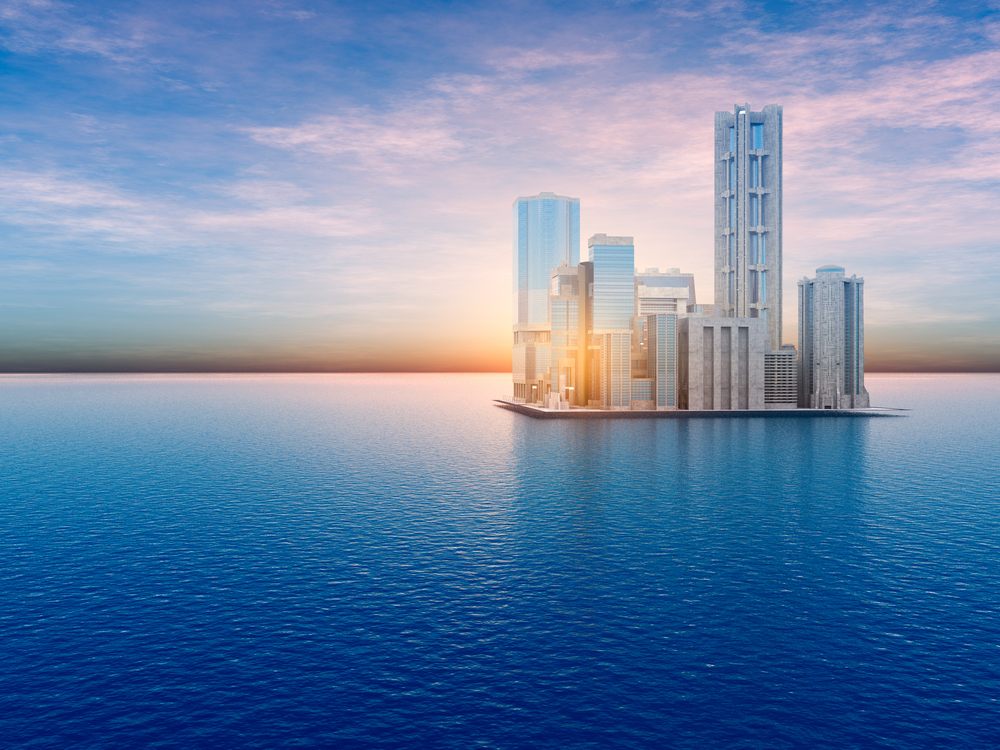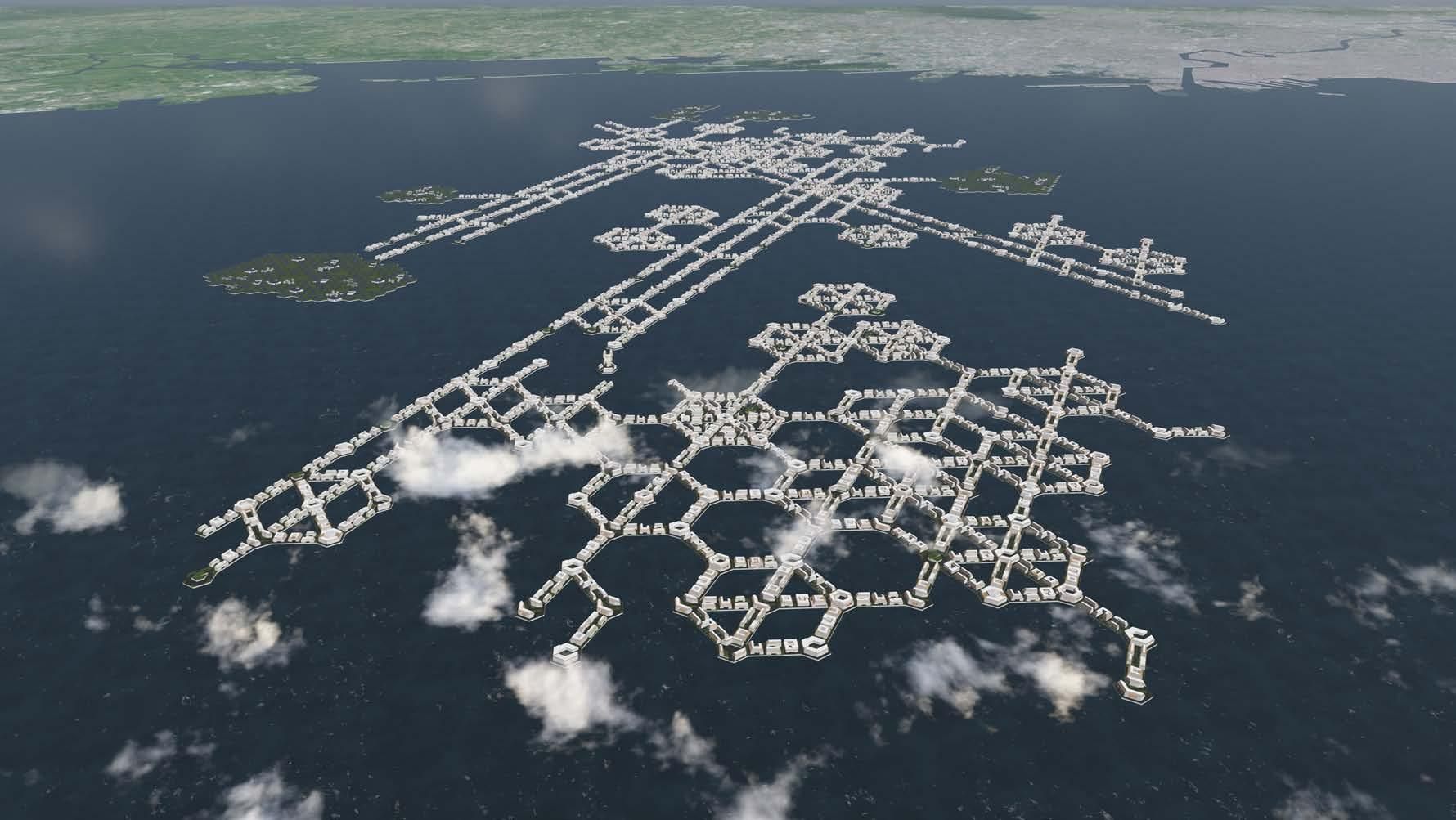The Dream of Building Floating Cities is Dragged Down by Reality
Seasteading is the biggest DIY project in the world—but everyone wants something different.

The first place winner, “Artisanopolis”, from the Seasteading Institute’s 2015 architectural design contest for floating cities. (Photo: Gabriel Scheare, Luke & Lourdes Crowley, and Patrick White/ CC BY 4.0)

Michael Eliot never liked the idea of government. So the former construction worker came up with an elaborate solution: he decided to build a country of his own, on international waters, to remedy the problem of having to live under the laws of others. For the last five years, Eliot has been working to design and build his own permanent floating dwelling, known as a seastead.
Voluntary anti-government communities, be they pirates or hippie communes, have existed for centuries. Seasteaders aim to take this concept to the next level, literally creating their voluntary societies from the ground up using experimental technology and techniques. Plans for these floating cities generally see them located on the high seas, outside of the Exclusive Economic Zones that are controlled by different nations.
Many of today’s aspiring seasteaders want to connect their private dwellings as detachable, modular houses. If they dislike how things are going in their new communities, they can just float away.

Can a floating city ever be a reality? (Photo: Dan Collier/shutterstock.com)
The less radically-minded might wonder: why go to all the trouble? Why not just haul off into the woods and live secluded from pesky neighbors? Most seasteaders would say these questions miss the point. They aren’t just looking for solitude, they’re looking for freedom from government control. Some are looking for new ways to survive in the rising waters of climate change. They’re looking, plainly, to change the world. And they have a lot to say about how.
Eliot, along with other aspiring seasteaders, envisions living in his own floating home among a group of other single-family, 2,000-square-foot houses that connect to one another through docks. The structures will float on long, fiberglass tubes made using a filament-winding technique. The design includes underwater parachutes that resist lifting and toppling from large waves, and a lightweight building material derived from Roman technology, called geopolymer concrete, which can withstand corrosive ocean waters.
He plans to begin building the inaugural two-story structure on land, and finish its interior on the ocean. Eliot believes he can complete his own seastead in the next three years. “It’s taken longer than I’d expected already due to the change in building process, but I think this new process is much more promising,” he says.

Another design, the ”Prismatic Module Island”. (Photo: Matias Perez/CC BY 4.0)
Eliot’s first introduction to seasteading was through science fiction: a novel by Neal Stephenson called Snow Crash. At first, he thought the idea was nothing more than a good setting for a novel of his own. “The deeper I looked the more convinced I became that this wasn’t just a sci-fi concept, that this was very close to being doable,” says Eliot, who began embracing libertarianism around the same time. “I was especially interested in the concept of private cities, so I saw this as an opportunity to experiment in stateless societies.”
While not exclusively so, seasteading and libertarianism, a political philosophy opposed to most government oversight and regulation, often go hand-in-hand. The idea of seasteading dates to 1993, when a 28-year-old named Eric Klein began dreaming of a new, libertarian society. As a successful investor annoyed with the concepts of government and taxes, Klein felt there were few places in the world he could fit in. The solution was a new country, Oceania, which would exist on a floating, man-made island out in the middle of the international seas.
Oceania would have no laws, with only a few rules listed in their lengthy constitution. Alternative marriages, open prejudice, bestiality, and renegade scientific research would be equally welcome—the only thing expressedly forbidden in Oceania was physically hurting others against their will. While predated by a similar idea in 1965, Oceania got little mainstream press and was frequently portrayed as a joke; a 1994 Miami Herald article dubbed it “Pleasure Island,” and emphasized “We’re Not Making This Up.”

A design for a house made from sustainable materials on the floating city “Five Petals”. (Photo: Emil Marvin Rozario Suerte/CC BY 4.0)
Unfortunately for Klein and his supporters, plans for Oceania crumbled only a year later, due to technology issues and ballooning project costs that were estimated at one billion dollars. But since the 1990s, enthusiasts like Eliot have been busy trying to make this type of floating city a reality.
Eliot moderates and participates in floating city subreddits, a hub of communication about seasteading. Enthusiasts share recipes for concrete, fabrication techniques and inspiration for alternative energy sources. “I’ve had dozens of people contact me with offers to help build and asking for ways to get involved. Which leads me to believe that once we get some traction going there’s going to be a lot of people who jump in and help build.”
The idea gained both traction and a deep-pocketed investor in 2008, when the Seasteading Institute, a nonprofit organization backed by the libertarian tech billionaire Peter Thiel, began exploring oceanic self-governance. Fellow libertarians and tech companies seeking to escape regulations such as visas eagerly voiced their support.
“From my vantage point, the technology involved is more tentative than the Internet, but much more realistic than space travel,” Thiel wrote in 2009. “We may have reached the stage at which it is economically feasible, or where it soon will be feasible.”
Last year, the Seasteading Institute announced that aims to build a floating city-state by 2020. But they’ve had walk back some of their core goals, after the exceptionally high costs of starting a new society from scratch on the deep seas proved dispiriting to supporters. For this latest plan, the group has pragmatically shifted into more regulated waters. “The high cost of open ocean engineering serves as a large barrier to entry and hinders entrepreneurship in international waters,” a 2015 vision statement announced. “This has led us to look for cost-reducing solutions within the territorial waters of a host nation.”

A hexagonal-shaped design for a floating city to be situated in Manila Bay. (Photo: Daniel Schwabe/CC BY 4.0)
Indeed, arguably the biggest challenge seasteaders will face will be getting governments to allow a group of mainly anti-government minded private property owners to live on international waters, and build their own economies and defense systems. Enthusiasts are somewhat defensive about the concept: “Most of our libertarian supporters do not expect to create a perfect libertarian paradise where they can do whatever they want without any interference,” states the Seasteading Institute’s FAQ. “They are simply looking for a significant improvement over the territorial status quo.”
Some of the DIY enthusiasts say it wouldn’t be so terrible if governments were more involved. “I think it’s essential to maintain good relationships with governments, especially starting out,” says Eliot. “People keep flippantly telling me that any government will just instantly shut down the first seastead.” He believes an agreement with a host nation would mitigate issues.
The Seasteading Institute seems to take this view, as well. According to a 2014 video, the organization is negotiating a deal with “several coastal nations,” which remain unnamed, to form platform cities on shallow waters. “We’ll make an announcement when we close a deal,” says spokesperson Joe Quirk. The cost, of according to the Seasteading Institute’s Floating City plan, will $500 per square foot, “about the cost of living in London or New York.”

“Storm makes sense of shelter”, another winning design from the Seasteading Institute’s contest. (Photo: Simon Nummy/CC BY 4.0)
Of course, another huge challenge for seasteaders is the feasibility of growing a society in such hostile environmental conditions. One enthusiast who wishes to be called by his reddit username “Piugattuk”, a 50-year-old truck driver from the U.S. who spent his formative years in the Navy, says he’s seen his fair share of unrealistic nation-building plans. “Many people in seasteading do not have real world experience in life on the water, things can go from 0 to 100 in the blink of an eye,” he writes. “Don’t get me wrong, I love the concept but I believe they don’t have the right people trying to make it happen from everything I read.”
He’s been on giant Navy ships that have taken on water, and notes that many preliminary renderings of floating cities look more like city parks than permanent residences ready to withstand ocean storms. “My stance has been, and always will be (until a real technology comes along), that anything that floats is doomed to failure,” he says, adding that maintenance will be costly, and that even oil-rig platforms sink.
While logistics divide them, seasteaders are not deterred from the conviction that their dream will be realized; it’s just a matter of when. “I want to see a million people living at sea in a stateless society in an established and permanent deep-water seastead,” says Eliot. “If we can do that, we will have changed the world forever, and opened up an entirely new frontier for the growth of humanity.”
Others are less grandiose about what they want out of seasteading. “I’m not looking for riches,” says Piugattuk. Mainly, he wants to live sustainably while pursuing his interests. “I’m talking about perfecting personal goals, music, writing, building, but in the rat race we live in it’s hard.”
If the technology improves, though, he’d like to be a seastead building consultant.







Follow us on Twitter to get the latest on the world's hidden wonders.
Like us on Facebook to get the latest on the world's hidden wonders.
Follow us on Twitter Like us on Facebook